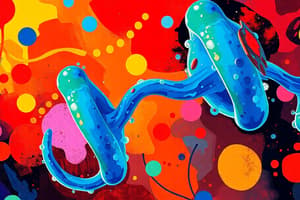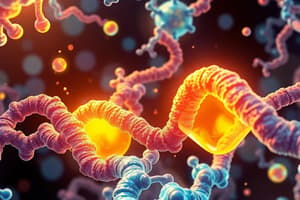Podcast
Questions and Answers
What is the main function of enzymes in living organisms?
What is the main function of enzymes in living organisms?
- Speeding up chemical reactions (correct)
- Destroying cellular compartments
- Breaking down complex molecules
- Synthesizing new cellular components
How are catabolism and anabolism related to metabolism?
How are catabolism and anabolism related to metabolism?
- Catabolism involves breaking down organic molecules, while anabolism involves the synthesis of complex molecules. (correct)
- Catabolism and anabolism both refer to the same process in metabolism.
- Catabolism involves the synthesis of complex molecules, while anabolism focuses on breaking down organic molecules.
- Catabolism and anabolism are not related to metabolism.
What is the primary structure of a protein?
What is the primary structure of a protein?
- Overall three-dimensional shape
- Local folding of the polypeptide chain
- Linear sequence of amino acids (correct)
- Linkage between proteins and nucleic acids
Where can enzymes be found in living organisms?
Where can enzymes be found in living organisms?
What type of bond links amino acids in proteins?
What type of bond links amino acids in proteins?
What is the role of protein shape in enzyme function?
What is the role of protein shape in enzyme function?
Which enzyme catalyzes the conversion of glucose to glucose-6-phosphate?
Which enzyme catalyzes the conversion of glucose to glucose-6-phosphate?
What does the acidic residue in an enzyme's active site do?
What does the acidic residue in an enzyme's active site do?
Which metabolic pathway converts glucose to pyruvate?
Which metabolic pathway converts glucose to pyruvate?
How do biochemists contribute to human health and wellbeing?
How do biochemists contribute to human health and wellbeing?
Flashcards
Enzyme
Enzyme
A protein that speeds up chemical reactions in living things.
Metabolism
Metabolism
All chemical reactions in an organism needed for life.
Catabolism
Catabolism
Breaking down organic molecules.
Anabolism
Anabolism
Signup and view all the flashcards
Protein Structure
Protein Structure
Signup and view all the flashcards
Primary Structure
Primary Structure
Signup and view all the flashcards
Secondary Structure
Secondary Structure
Signup and view all the flashcards
Tertiary Structure
Tertiary Structure
Signup and view all the flashcards
Hexokinase
Hexokinase
Signup and view all the flashcards
Glycolysis
Glycolysis
Signup and view all the flashcards
Study Notes
Uncovering the Secrets of Biochemistry: Enzymes, Metabolism, and Protein Structure
Enzymes: The Biochemical Catalysts
Enzymes are protein-based biological catalysts that speed up chemical reactions in living organisms. They enhance reaction rates, often by orders of magnitude, without being consumed in the process. Enzymes are highly specific, meaning they only catalyze particular chemical reactions, and can be found in various locations such as cells, cellular compartments, and extracellular fluids.
Metabolism: The Chemical Processes of Life
Metabolism is the sum of all chemical reactions that occur within an organism to maintain life, from converting food into energy to the synthesis of new cellular components. Metabolism can be classified into two categories: catabolism (breakdown of organic molecules) and anabolism (synthesis of complex molecules). Biochemistry explores these metabolic pathways to understand the molecular processes that sustain life and reveal opportunities for therapeutic intervention.
Protein Structure: The Building Blocks of Life
Biological macromolecules, including proteins, are composed of amino acids linked together by peptide bonds. Protein structure is hierarchical, with the primary structure being the linear sequence of amino acids, the secondary structure being the local folding of the polypeptide chain, and the tertiary structure being the overall three-dimensional shape of the protein. This shape is crucial for the protein's function, as it allows them to interact with other molecules, such as substrates, cofactors, or other proteins.
Case Study: Enzyme Mechanisms and Metabolic Pathways
Consider the enzyme hexokinase, which catalyzes the conversion of glucose to glucose-6-phosphate. This reaction is the first step in glycolysis, the metabolic pathway that converts glucose to pyruvate. The enzyme's active site contains an acidic residue that forms a covalent bond with the glucose, positioning it for the nucleophilic attack of the hexose phosphorylation group. The metabolic pathway further breaks down glucose-6-phosphate into pyruvate, yielding ATP and NADH, providing energy for cellular processes.
Conclusion
Biochemistry is a fascinating field that continues to reveal the intricate molecular mechanisms underlying life. From exploring enzyme mechanisms to understanding metabolic pathways, biochemists investigate the complex relationships between proteins, genes, and cellular processes to promote human health and wellbeing. By continuing to build on our understanding of these fundamental biochemical processes, we can develop novel therapies and technologies that improve our quality of life.
Studying That Suits You
Use AI to generate personalized quizzes and flashcards to suit your learning preferences.




